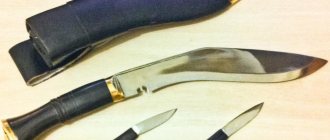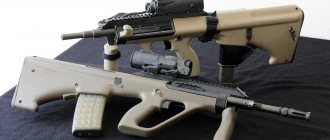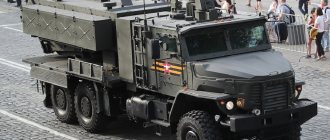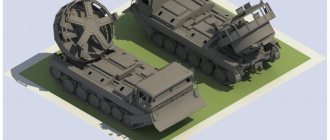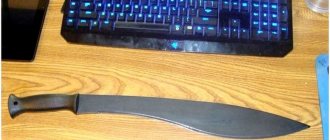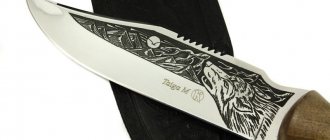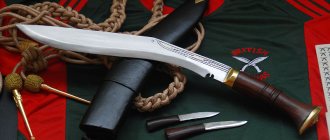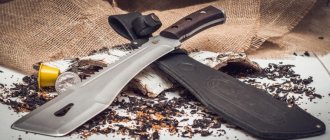Among the universal working and combat weapons, one can hardly find an object more brutal than a machete, a knife equally suitable for cutting cane and for hand-to-hand combat.
Born as a tool of labor, the machete has a long and glorious history as a weapon of liberation, and an auxiliary item in jungle wars, and even dark pages of use by criminal groups. The long history of the machete does not end; having received a new impetus, this weapon continues to develop.
Condor Parang Machete
Designed for use outdoors, in the jungle and thickets, for preparing firewood for a fire. The blade widens towards the end and has a shortened tip. This shape allows the knife to have excellent chopping properties. The blade and handle are made of 1075 carbon steel. The hardness and toughness of the material give it excellent cutting properties. Stops on the handle prevent you from dropping the knife from your hand.
Combat use
The use of machetes on the battlefield began with the national liberation movements in Central and South America. The slaves had no weapons other than their shackles and farm knives.
The past of the cutlass quickly made itself felt, yesterday's slaves famously fought with lightly armed detachments of police and gendarmerie. American and European journalists and officers took part in these battles as observers and advisers and offered this version of the knife for their armies.
Since the Second World War for the Americans was primarily the Pacific Theater, the machete came in handy. Marine detachments made their way through the jungle thanks to these simple knives. In addition to being a tool for destroying reeds, the machete served as a small sapper's shovel.
The thickness and width of the blade was enough to dig soft soil or sand. The Asian allies were impressed with the machete. There were many folk examples of similar weapons, so the machete soon took pride of place among the bladed weapons of this region.
Gerber Bear Grylls Parang Machete
The design is reliable and simple, the handle is ergonomically shaped and made of non-slip corrugated material. There is a hole on the handle in which a loop is attached. The knife comes with a comfortable sheath, which has a pocket.
Knife with a blade 34.3 cm long, weight 0.5 kg. The machete is suitable for short and long hikes. The knife set comes with instructions for survival in crisis conditions.
Machete: what to choose?
A machete is a long knife with a generally thin and wide blade. In this article, this term is used not only to refer to a useful tool. It names the production programs of a number of companies. Modern machetes come in a variety of shapes, which have been refined over time in different countries to suit their purpose of cutting and chopping. The staff of the German magazine DWJ conducted some market research.
Of all the currently known machetes, the classic one is considered to be the Latino type, used for harvesting sugar cane. This machete has a 3 mm thick blade with a slight increase in its width towards the tip while maintaining a straight spine. The toe is more blunt than sharp. The last quarter of the cutting edge is curved towards the tip. The bend radius in relation to the butt is approximately 1/4 of its length. The long straight cutting edge of the Latino style is suitable for cutting as well as chopping, which is facilitated by the weight of the blade, its thickness and width. The variety of machete shapes is due to the requirements in countries with different climatic conditions.
In the Bolo type, the increase in the width of the blade towards the tip is even greater, and accordingly, the center of gravity shifts towards it. Therefore, compared to the Latino machete, the Bolo type is more suitable for chopping.
Camillus' Carnivore X Combo is versatile. Therefore, the manufacturer abandoned the use of the classic machete shape.
In the Parang species, the blade is curved throughout, and its width increases towards the tip. The blade tapers at an angle to the handle, which gives an advantage when cutting.
The Slant Tip was designed for chopping and slicing. Its blade width increases all the way from the handle to the tip, which is an acute angle between the straight cutting edge and the butt. Due to the shift of the center of gravity to the tip during operation, the appearance of the Slant Tip resembles a small axe. The difference is that the machete is better suited for cutting.
The Khukri type is something between a working tool and a combat knife. Here, at the handle, the blade has the smallest width, which increases from the middle of the blade towards the cutting edge. The blade is at its greatest width approximately 3/4 from the handle. There is a sawtooth sharpening on the butt. Significant thickening of the blade towards the tip provides good cutting characteristics.
Cold Steel's All Terrain Chooper model has a Slant Tip blade, which has a center of gravity as close to the front as possible, which is best suited for chopping.
The Barong type is something between a working tool and a combat knife. Its blade in its shape resembles the silhouette of a fish: up to the middle, its thickness from the side of the cutting edge and butt gradually increases in proportion, and then tapers off to the tip, which, unlike classic machetes, has a knife-sharp sharpening.
The machete from Camillus has a special shape. The blade of the “American tanto” type has the same thickness and width throughout, and the tip is an obtuse angle between the straight cutting edge and the butt. This allows this machete to be used as a chiseling tool. The sawtooth sharpening is not applied over the entire length of the butt, which makes it possible to use it as a hammer with a narrow striker.
The impact performance of Condor's Eco-Parang model is impressive.
Of course, there are other forms of machetes. In particular, there are numerous models for sale for survival in extreme conditions (Survival Machete), combat models, as well as the Zombie-Dead-Machete model from the manufacturer Haller. In this case, the concept of “machete” serves to designate the length of the blade, which is intermediate between the blades of a knife and a saber.
Blade
For known types of machetes, the blade length ranges from 250 to 650 mm. Regardless of the shape of the model, some manufacturers apply a sawtooth sharpening to the butt, which allows the machete to be used as a small saw. However, unfortunately, in this case, what is desired does not always correspond to reality. In particular, employees of the German magazine DWJ, when testing the machetes provided, in some cases found straight saw teeth without setting on the butt, as a result of which it was, at best, suitable for use as a rough rasp. But there was also a very sharp sharpening, performed in compliance with all requirements, which made it possible to use the machete as a full-fledged saw. As for sawtooth sharpening, in any case, catalog texts should be treated with a certain degree of skepticism.
A positive or negative assessment of a machete in operation mainly depends on the grade of steel from which the blade is made. It should be easily and efficiently sharpened, the cutting edge should maintain sharpness for as long as possible, and the thickness of the blade should prevent it from breaking and elastic deformation. These requirements are met by carbon steels, grade AISI-420, as well as the famous Swedish steel Sandvik 12C27. However, of these, only the AISI-420 grade is stainless. Blades made from other steels require the application of a special coating or the use of anti-corrosion agents. At the same time, sometimes coatings are not durable enough. In particular, in some of the machetes tested, even simple chopping blows to wood caused damage to the coating.
The blade of the EKA Mach Blade W1 is made of 12C27 steel, also known as Swedish steel.
When purchasing a machete, one of the deciding factors is the length of the blade. For those who plan to use the machete primarily to remove tall grass, small thickets, or brush, models that are primarily designed for cutting will be better suited. A long, thin blade will also be an advantage. To cut branches that are not too thick, it is more effective to use a machete with a thick, medium-length blade. It is less susceptible to bending and elastic deformation, which cause discomfort when chopping.
The weight of a machete depends on the length and thickness of the blade, as well as the material from which it is made. In turn, weight affects the force of the blow. Compared to a light machete, applying the same force with a heavy weapon can deliver a more powerful blow. At the same time, when performing small jobs with a heavy machete, as well as when wearing it for a long time, more physical effort will be required.
The Gerber Bear-Grylls-Parang machete has a handle with a soft material insert. Its blade is curved throughout, and the width increases towards the tip.
Often machetes have a center of gravity shifted to the front, which makes it easier to chop branches and small trees. For those who plan to use this tool primarily for cutting or removing tall grass and small bushes, it is recommended to use models with a center of gravity slightly shifted to the front. Of course, this recommendation is not mandatory. If you are using a machete for cutting large areas, you will need a model with a long blade, which provides a wide grip and accordingly increases productivity. A machete with a thin blade is best for this.
And finally, let's try to answer the question: what kind of work are blades with different sections intended for? The blade with concave slopes has the greatest sharpness, which is good for cutting, but not suitable for chopping, as it can be pinched. A blade of medium sharpness with convex slopes allows you to avoid this. At the same time, such a machete is not entirely suitable for cutting, for example, removing small bushes and tall grass.
Handle
As a rule, a machete is grasped with one hand, which is what its short handle attached to a straight shank is designed for. Finger grips, the head of the hilt, the front guard, or even a closed hilt contribute to reliable holding of the machete when chopping. Some models, as well as machetes with very long blades, have a handle that provides a two-handed grip, which allows you to increase the force of the blow when cutting down brush, branches or small trees.
Cold Steel's Barong model features a double-convex blade that is shaped very well for cutting.
When purchasing a machete, you should pay attention to the fact that the handle is comfortable. It must be securely screwed to the shank, pressed tightly onto it (for Full-Tang models) or riveted along its entire length. With these fastening methods, the handle cannot come off the shank. The editors of the German magazine DWJ do not take responsibility for stating which material is best suited for the manufacture of handles. Its shape is important, allowing you to securely hold the machete while chopping without strain. In addition, the shape corresponding to the hand of the machete owner, as well as the outer covering of the handle, play an important role here. Various manufacturers make notches, finger grooves, inserts made of soft materials, guards and grooves on the handles in accordance with their individual design and design solutions. When buying a machete, it is recommended to first hold the model you like in your hand and determine whether it is suitable.
An advantage would be the presence of a hole at the end of the handle for attaching a safety cord. For chopping that requires a lot of effort, it can be wrapped around the hand, which will prevent the machete from slipping out of the hand.
Sheath
The machete must have reliable fastening devices that ensure the safety of the owner. The delivery set for models with a long and sharp blade includes a rigid sheath that ensures safe removal/insertion of the machete and can last for a long period of time. There is quite a large number of different sheaths: from thin simple ones made of cordura, following the contour of the blade, sewn with one seam without additional reinforcement with rivets, to very durable ones made of plastic.
The Bolo machete from Herbertz has a wide front part, which ensures that the center of gravity of the blade shifts towards the tip and, accordingly, leads to an increase in impact force.
You should pay attention to the number of possible ways to attach the sheath, including attachment to ammunition, where, in particular, to a backpack, long and heavy machetes are often attached (the sheath must have appropriate loops or eyes).
Market Review
Of the machetes available on a fairly large market, the editors of the German magazine DWJ received specimens that met the above features for testing from well-known manufacturers and distributors. All provided models had an optimal price-quality ratio, although some manufacturers partially used materials that were not designed for long service life. The very simple machetes produced by Herbertz, in terms of the choice of materials and equipment, can most likely be classified as cheap products. They do not belong to the class of professional tools and are intended for occasional use. Models costing 50 euros are better in the choice of materials and equipment elements and increase work efficiency. They are suitable for work that requires significant physical effort. For example, the Herbertz company offers machetes with a wooden handle and a choice of blade lengths of 250, 360 and 460 mm. The durable blade is made of AISI-420 steel, has a thickness of 4 mm and a medium sharpness. With increasing length, its center of gravity is proportionally shifted to the front. Therefore, a machete with a maximum blade length is intended for chopping. It is very heavy for cutting and doing delicate work.
Herbertz offers three classic machetes with blades of varying lengths.
Camillus' Carnivore X Combo is versatile. Therefore, the manufacturer abandoned the use of the classic machete shape. This model has a very sharp cutting edge, and large saw teeth are applied to the butt. This machete is optimally suited for cutting and sawing. Almost without tapering, the butt transforms into an “American tanto” type point. Thus, in the area of the tip the blade is strong enough to be used as a lever or an improvised crowbar. The front part of the butt has a small chamfer on both sides, which, if necessary, makes it possible to use it as a hammer. In front of the “hammer” there is a skinning hook. The blade has a cross-section with fairly wide concave slopes, its center of gravity is not shifted to the front, and the length is determined by the optimal weight of the machete. The disadvantage is the smooth surface of the plastic handle. It is pimply, but overall the texture does not provide a reliable hold.
For those who would like to purchase a chopping tool that is of medium size and weight, the Bolo model from Herbertz is quite suitable. The Bolo machete has a wide front part, which ensures a shift in the center of gravity of the blade towards the tip and, accordingly, leads to an increase in impact force. Combined with a sharp cutting edge, this allows for very efficient cutting. This model has a very well designed plastic handle. It has transverse grooves in the upper part at the front and back, and in the middle part there are convex inserts made of soft material with a notch on both sides. The handle is ergonomic, feels nice and secure in the hand.
Haller's Khukri model has the fingers protected by a closed hilt, the bow of which connects the base of the handle to the pommel.
An alternative to the classic machete are Parang models, for example the Bear-Grylls-Parang machete or the Eco-Parang machete from Gerber and Condor, respectively. Their blade is curved throughout, and its width increases towards the tip. The blade tapers at an angle to the handle, which gives an advantage when chopping and reduces the load on the working hand. The Bear-Grylls model has a plastic handle with a rough surface mounted on a tang. It is made by injection molding, has a good shape and has inserts made of soft material. The Condor machete handle fits its purpose perfectly.
As for the protection of the working hand, the Khukri model from Haller should be highlighted here. Her fingers are protected by a closed hilt, the arch of which connects the base of the handle with the pommel. The unusual shape of the blade of this model, which combines a working tool and a weapon, corresponds to Nepalese and Indian traditions.
The MachTac III model from Carl Walther differs in its design from all the machetes described above. This model has a classically shaped blade, and a very long hilt reminiscent of the hilt of the Dha sword (other names: Daarb, Dha-Iway Dhaarb) - a traditional weapon in Myanmar (formerly Burma).
The Zombie-Dead-Machete from Haller, among other things, impresses with its modern, eye-catching design.
Cold Steel's two models are also not shaped like classic machetes. The All Terrain Chooper model has a Slant Tip blade, most suitable for chopping. The long straight cutting edge of a thick carbon steel blade is well suited for cutting, and best of all for chopping, since the center of gravity of the blade is maximally shifted to its front part. The manufacturer has equipped this model with a long handle with a front guard that is easy to grip with two hands.
The Barong Machete also has a sharp carbon steel blade whose double convex shape is very suitable for cutting. The thin long tip of this model is not typical for a machete. This is a tribute to the tradition of using the Barong model as a working tool and weapon.
The handle of Walther's MachTac III is designed for two-handed grip, which is an advantage for heavy-duty work.
Those who would like to have a machete with a blade made of high-quality steel are recommended to opt for the Mach Blade W1 model, produced by the Swedish company EKA and having a blade made of 12C27 steel. It has a classic Latino shape with a surface obtained by processing in a vibrator using rolling stones with additional grinding materials (stonewashed). The cutting edge is very sharp. The grade of steel used allows you to maintain sharpness for a long period of time. There is a sawtooth sharpening on the butt. Unfortunately, its short length allows only limited use of the machete as a saw.
DWJ findings
A machete is a good option for combining the functions of a knife and a small ax. The various models are best suited for the respective everyday use. A wide selection of machetes of different shapes and designs allows you to purchase a model that best suits the individual wishes of the buyer.
Axel PIckstro..er Translation by Victor Nazarov
Cold Steel 97AD18Z Latin D-Guard
Machete with a very sharp blade, a durable handle with a guard to protect the hand. The blade is made of solid 1055 steel with a matte black finish, and the handle is made of wear-resistant, durable polypropylene. The sheath is made of Cor-Ex material with a belt mount and protects the knife during transportation and storage.
Cold Steel 97AD18Z Latin D-Guard is great for field applications. They can cut branches and prepare firewood. The knife is reliable, relatively inexpensive, and can be used both at home and outdoors.
The knife is “more alive than all living things”
Despite the fact that the world is moving forward, and many examples of peasant weapons can be found in museums, there can be no talk of stopping the production and use of machetes. Of course, over the many years of history, this weapon has undergone many changes, but it is just as in demand as before.
Jungle raids, both by guerrillas and government forces, and numerous search and rescue operations require this simple and reliable weapon.
In many areas it is still used for its intended purpose by peasants. They know very well how to choose a machete depending on the tasks assigned to it.
They continue to produce machetes around the world. The Brazilian company Tramontina produces a line of inexpensive samples of these weapons. Machetes are also created in Russia.
The samples presented on the domestic market do not differ in anything special from world standards. There are both low-quality knives on sale and expensive but worthy items that can serve for many years.
The main thing here is to understand why you need a machete, hang it on the wall, scare the neighbors, or go live in the forest. However, numerous reviews make it clear that in Eastern Europe the machete is not best suited for serious hiking trips or “survivalist” raids.
Specifications
| Tramontina Machetes 12” | Tramontina Machetes 14” | Tramontina Machetes 16” | Tramontina Machetes 18” | |
| Blade type | Machete – raising the butt to the tip, wide rounding of the cutting edge | |||
| Blade length (mm) | 320 | 350 | 400 | 450 |
| Steel | SAE 1070, carbon, analogue of Russian U8 and U10A | |||
| Butt thickness (mm) | 2 | |||
| Handle | Dies made of wood or plastic, assembled with rivets | |||
| Weight (gram) | 290 | 330 | 350 | 370 |
| Overall Length (mm) | 430 | 480 | 540 | 580 |
A trace in the minds and memories
For most of the population, the machete is remembered thanks to numerous horror or trash films. The main character, villain, whatever, armed with a terrible knife, smashes left and right, chops teenagers and scoundrels into cabbage and delivers justice/revenge, often with a devilish laugh.
Under this short description we can sum up films from “Friday the 13th” to “Machete Kills,” which are so popular among the population. The use of a machete directly for its intended purpose can be seen in almost any adventure or war film set in the jungle.
One of the funniest moments of "surprise" when passing through dense foliage is shown in the movie "Romancing the Stone."
For many, a machete, a cane knife, is a weapon or tool of everyday labor, without which it is impossible to earn a piece of bread or protect your life.
It is for this reason that this knife has become so widespread. It is relatively easy to buy as a souvenir for your home. By the way, according to the law, a machete is not considered a weapon, so the circulation of most of these knives is completely legal.
About the origin
The blade appeared in the regions of South America after the arrival of the Portuguese and Spaniards there. The local population used this product as a large and light reed knife. It was used to cut sugar cane, corn stalks and other crops. Also, using this equipment, the colonists cleared their way through the jungle. Today there are several versions about the origin of the machete. According to one of them, the long knife is a descendant of the kopis, the sword of the ancient Greeks. Proof of this theory are the design features of the Javanese parang - one of the varieties of concave machetes. The weapon's appearance is very similar to the kukri, which the Gurkhas once used. All three types of bladed weapons are characterized by a boomerang-like shape. However, the convex part of the blade is sharpened in the parang, and the concave part in the kukri.
Blade sharpening
Since the blade thickness is 3 mm, it is difficult to sharpen immediately. First you need to make gentle slopes that will give the lower cutting part of the blade a wedge shape. For this work, you can use a grinder with a petal attachment. The rotation speed of the grinding machine is very high. It can easily overheat the workpiece and thereby overheat it. To prevent this from happening, you need to work with minimal pressure, without holding the petal circle in one place.
After giving the wedge shape, the blade is further sharpened on an emery machine. In order for sharpening to be accurate, the abrasive wheel should not have runout. The blade is sharpened at low speed with constant cooling with water. The handle of the machete must be made after giving the workpiece slopes, but before sharpening.
